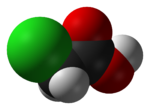클로로아세트산

| |

| |
| 이름 | |
|---|---|
| 우선명 (PIN)
Chloroacetic acid | |
| 체계명
Chloroethanoic acid | |
| 별칭
2-Chloroacetic acid
2-Chloroethanoic acid | |
| 식별자 | |
3D 모델 (JSmol)
|
|
| 3DMet | |
| ChEBI | |
| ChEMBL | |
| ChemSpider | |
| ECHA InfoCard | 100.001.072 |
| EC 번호 |
|
| KEGG | |
PubChem CID
|
|
| RTECS 번호 |
|
| UNII | |
CompTox Dashboard (EPA)
|
|
| |
| |
| 성질 | |
| C2H3ClO2 | |
| 몰 질량 | 94.49 g·mol−1 |
| 겉보기 | Colorless or white crystals |
| 밀도 | 1.58 g·cm−3 |
| 녹는점 | 63 °C (145 °F; 336 K) |
| 끓는점 | 189.3 °C (372.7 °F; 462.4 K) |
| 85.8 g/100mL (25 °C) | |
| 용해도 | Soluble in methanol, 아세톤, 다이에틸 에터, 벤젠, 클로로포름, 에탄올 |
| log P | 0.22 |
| 증기 압력 | 0.22 hPa |
| 산성도 (pKa) | 2.86[1] |
자화율 (χ)
|
-48.1·10−6 cm3/mol |
굴절률 (nD)
|
1.4351 (55 °C) |
| 구조 | |
| Monoclinic | |
| 열화학 | |
열용량 (C)
|
144.02 J/K mol |
표준 생성 엔탈피 (ΔfH⦵298)
|
-490.1 kJ/mol |
| 위험 | |
| 주요 위험 | alkylating agent |
| 물질 안전 보건 자료 | External MSDS |
| GHS 그림문자 |   
|
| 신호어 | 위험 |
| H301, H311, H314, H331, H400 | |
| P260, P261, P264, P270, P271, P273, P280, P301+310, P301+330+331, P302+352, P303+361+353, P304+340, P305+351+338, P310, P311, P312, P321, P322, P330, P361, P363, P391, P403+233, P405, P501 | |
| NFPA 704 (파이어 다이아몬드) | |
| 인화점 | 126 °C (259 °F; 399 K) |
| 470 °C (878 °F; 743 K) | |
| 반수 치사량 또는 반수 치사농도 (LD, LC): | |
LD50 (median dose)
|
165 mg/kg (mouse, oral) |
| 관련 화합물 | |
관련 화합물
|
2-Chloropropionic acid Sodium chloroacetate |
달리 명시된 경우를 제외하면, 표준상태(25 °C [77 °F], 100 kPa)에서 물질의 정보가 제공됨.
| |
클로로아세트산(영어: Chloroacetic acid, 화학식 : ClCH2CO2H)는 유기 염소산이다.
각주[편집]
- ↑ Dippy, J. F. J.; Hughes, S. R. C.; Rozanski, A. (1959). “498. The dissociation constants of some symmetrically disubstituted succinic acids”. 《Journal of the Chemical Society》 1959: 2492–2498. doi:10.1039/JR9590002492.
| 이 글은 화학에 관한 토막글입니다. 여러분의 지식으로 알차게 문서를 완성해 갑시다. |

